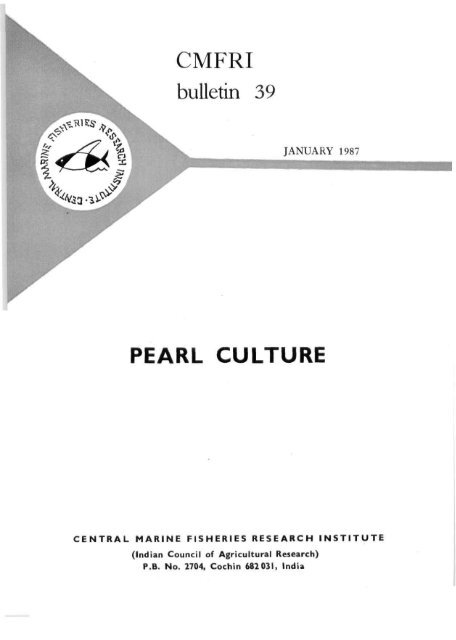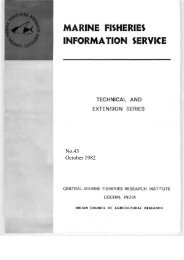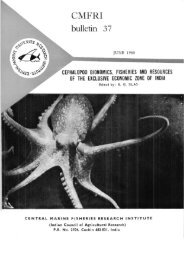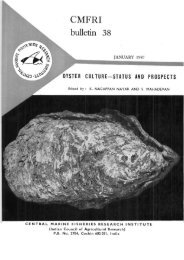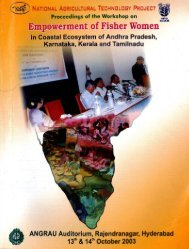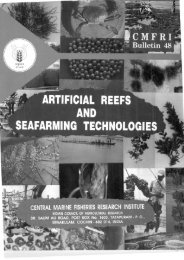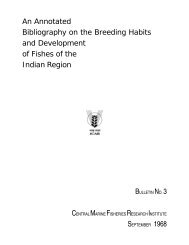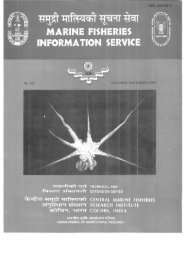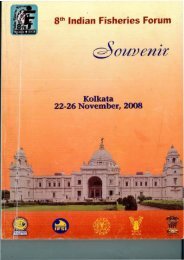pearl culture - Eprints@CMFRI - Central Marine Fisheries Research ...
pearl culture - Eprints@CMFRI - Central Marine Fisheries Research ...
pearl culture - Eprints@CMFRI - Central Marine Fisheries Research ...
Create successful ePaper yourself
Turn your PDF publications into a flip-book with our unique Google optimized e-Paper software.
JANUARY 1987PEARL CULTURECENTRAL MARINE FISHERIES RESEARCH(Indian Council of Agricultural <strong>Research</strong>)P.B. No. 2704, Cochin 682 031, IndiaINSTITUTE
CMFRIbuUetin 39JANUARY 1987PEARL CULTURE€dlted by: K. ALAGARSWAMICENTRAL MARINE FISHERIES RESEARCH INSTITUTE(Indian Council of Agricultural Researcli)F.B. No. 2704, Cochin 682 031, India.
12PROSPECTS FOR SELECTIVE BREEDING OF PEARL OYSTERS IN INDUT. S. VELAYUDHAN^INTRODUCTIONRecently a variety of approaches has been introducedin the field of genetics of molluscs, including Mendeliangenetics, cytogenetics, quantitative genetics, biochemicalgenetics and hybridization. Wada (1975 a, b, 1985) hasestimated the response to selection for several attributesof Pinctada fucata for sheU variance of full siblings.He analysed the genetic variability and gene frequenciesat three loci in two strains selected for four to fivegenerations. The change of frequencies of colour ofnacre in the selected lines of <strong>pearl</strong> oyster to yellowprismatic layer for five generations has been studied(Wada, 1985). Wada (1976, 1985) and Wada andKomaru (1985) have studied the chromosomemorphology of different species of bivalves.VAWATIONS IN INDIAN PEARL OYSTER POPULATIONIn India, Alagarswami et al. (1983) artificially produced<strong>pearl</strong> oysters from wild brood. Ala^rswamiand Chellam (1977) have reported the change of formand dimensional relationship in the <strong>pearl</strong> oyster P.fucata from Tholayiram, Pulipimdu and Kudamuthupaars and compared the regressions of different shellcharacters in young and adult oysters from the threepaars which indicated the heterogenous nature of thepopulation. Homell (1922) stressed the need for aknowledge of the special growth peculiarities of <strong>pearl</strong>oysters from the different beds since some paars byreason of abundant food supply hasten the growthof oysters to surprising degree, while others wher? lessfavourable conditions prevail have oysters of an unhealthyappearance and stunted size. Herdman (1905)reported that the <strong>pearl</strong> oysters from Cheval paar (SriLanka) v^ere fairly evenly distributed and in qualitythey proved to be best of all those examined or fished.They were all well grown, healthy and richer in good<strong>pearl</strong>s than any other. For <strong>pearl</strong> <strong>culture</strong> an accurateknowledge of the various traits of the oysters fromdifferent paars is necessary ia order to pick up thenecessary traits to be developed in the brood stock.The <strong>pearl</strong> oysters P. fucata and P. sugillata VKKsuccessfully crossed at the <strong>Central</strong> <strong>Marine</strong> <strong>Fisheries</strong><strong>Research</strong> Institute and viable spat were produced.P. fucata without black lamellar growth on the outershell were produced by inbreeding. Attempts havealso been made to produce cent percent P. fucatawith black lamellar growth on the outer shell by inbreeding.SELECTIVE BREEDING AND HERTTABIUTY OFPEARL OYSTERAccording to Wada (1975 a, b, 1985) the estimatedheritability of the shell size of P. fucata was greaterat one year of age than at two years but not muchdifference was observed in the shell shape. Wada(1985) has mentioned the heritability of the shell traitto be about 0.22-0.25 and that selective breeding of thetrait would be effective for other shell traits sudi asshell beiglht and shell width also. Wada has reportedthe change of frequencies of colour of nacre in theselected lines of <strong>pearl</strong> oyster to yellow prismatic layerfor 5 generations. No significant difference was observedin the mortality of <strong>pearl</strong> oysters and the rate oflow grade <strong>pearl</strong>s between two groups such as whiteand yellow prismatic layer secreting forms. Wada(1985) specifically mentioned the frequency distributionof shell weight of three year old <strong>pearl</strong> oyster of backcrossed (TNT,,NTT and the selected TL) lines in the' Present address : CMFRI, <strong>Research</strong> Ceatre, Tuticorin.628001,CMFRI BULLETIN 39 87
third year. Wada (1975 a, b) conducted crossing experimentsbetween DD and DD as well as with beterozygotesDF and DF. In the former only DD bandsappeared and in the latter three band types DD, DFand FF segregated. And he explained the NamakoLagoon of Kamikashijma Island may be geographicallyseparated from other habitats of <strong>pearl</strong>oyster, but it should not be assumed that the samplesconsisted of two or more populations with differentgene frequencies as in the case of excess homozygotesand he doubted whether negative heterosis operated.He illustrated the zymogram of maleate dehydrogenase(MDH) of crude extract from digestive diverticulumshowing mobility of each MDH band population.Wada (1976) studied the morphology of chromosomesof the oyster P. fucata (Gould) collected from the tworegions of Japan. Wada and Komaru (1985) explainedthe karyotypes in 5 species of Pteridae. Haley (1977),as reported by Newkirk (1980) has been followingthe frequency of changes in the 5 fuUsib families ofCrossostrea virginica. Matsui (1958), in Pinctadamartensii the right sheU is slightly convex, whereasthe left shell is more strongly so. The degree of convexityof shells is very important from the practicalpoint, because oysters with more strongly convexshells harbour larger <strong>pearl</strong>s. Haley (1978), as reportedby Newkirk (1983) explained that the sex determinationof these oysters was a three locus (two alleles each)model with certain genotypes as fixed males and othersas fixed females and the remaining with potential sexchange.From the studies on chromosomes of differentspecies of <strong>pearl</strong> oysters, it is clear that there are possibilitiesfor cross breeding of those bivalves which arehaving same number of chromosomes. Singlh andGreen (1984) have reported that the relative mortalityof the heterozygotes (faster growers) of Macomabalthica during the larval period is expected to varyfrom year to year depending on the environmentalconditions, particularly the relative abundance of thephytoplankton blooms and faster growing heterozygoteswith higher food requirements have relatively highermortality. This may account for the poor spat yearswhere relatively few larvae grow into spat and in suchyears there are also slow growers which take longertime to reach market size (Galtsoff, 1964).From the experimental results obtained in his observationand other studies Wada (1975) stated that the<strong>pearl</strong> oyster of Namako Lagoon may be a form of P,fucata (Gould) more or less generally differentiatedfrom the species of other habitats in Japan.AKAPPROACH TO PEARL OYSTER GENETIC STUDIESIN INDIAIn animals with external fertiUzation meiosis takesplace in the egg and artificial process can be appUedto either gamete before fertilization or later to altergenetic characters to fertilized egg or at any periodduring the formation of zygote. Suppressing metaphaseprevents replicated chromosome sets from separatinginto daughter cells and it can be achieved either byphysical means such as pressure or temperature shockor by use of chemicals such as colchicine or its analoguecoldmid. The more phenotypic variation in a traitthe more intense the selection from the natural populations.The selected oysters are then mated accordingto a prearranged plan. Unless there are suflBcientnumbers of spawners, at least 50, significant inbreedingmay occur and a number of stocks can be taken andperformanoe evaluation could be done during the firstgeneration.With very little or no information as guidance inchoosing stocks there are several approaches that canbe used. First, a simple stock based on availableinformation can be chosen. This can be risky if theinformation on which the decision relies is incomplete.Taking all our eggs from one source is really ' puttmgall our eggs in one basket.'Second, one can take a number of stocks and doperformance evaluation during the first generation.This will require maintaining stock identity and performancerecords.The third approach is to cross males and femalesfrom different populations to form mixed base population.This can be done if parents from a number ofstocks spawned together. We have produced <strong>pearl</strong>oysters without black lamellar growth on the shell inthe laboratory. P. fucata and P. sugillata were crossedand spat were produced. Maintenance of broodstockis useful to keep the identity of the progenygroups. If we keep each generation (50 males and 50females) of each stock or line, the inbreeding rate willbe 0.5 % per generation and total accumulation of inbreedingafter 5, 10 and 20 generations of 1, 3 and 5%respectively (Newkirk, 1983). More control can beexercised and consequently less inbreeding will occur ifseparate lines ate maintamed. If the founding stockhas been derived from a small number of parents (10-20)it is strongly recommended that separate familiesshould be maintained at least in the first generation.Thereafter a number of pooled lines can be formed bycareful crossing of the original families. At presentthe crossing of jP./i
due to the fear of the problem of interbreeding andadverse eflfect on the local strains, the wild stockis used as brood for increasing the farm stock. Andnow we are using the hatchery stock also as one of thelines for stock improvement. In the larval period aswell as adult stage we face many problems such asslow growth, mortality etc. To increase the qualityof <strong>pearl</strong>s and growth and survival of oysters we have toadopt some genetic approaches to raise the qualityof stock. From the natural stocks, these qualitieshave to be identified and the broodstock with necessarytraits could be used for producing <strong>pearl</strong> oysters ofdesired traits. The genetic diversity of different populationsof <strong>pearl</strong> oysters of India has to be identifiedto improve the quality of the product foraqua<strong>culture</strong>.The <strong>pearl</strong> oysters collected from different paars haveto be examined for the rate of <strong>pearl</strong> production, quality.mortality, growth variance, shell size, shell weight,meat weight and colour of nacre. Along with this,hatchery development of stocks from the requiredpaars has to be carried out. The heritability of <strong>pearl</strong>oyster has to be studied. The genetic variability ofthe <strong>pearl</strong> oyster P. fucata (Gould) collected from Gujarat,Lakshadweep, Andaman Islands, Vizhinjam and Tuticorinhas to be determined by studies on the numberand gross morphology of chromosomes in <strong>pearl</strong> oysterscollected from the above regions. Experiments shouldalso be carried out on the electrophoretic markers fordifferent traits of <strong>pearl</strong> oyster species in India. Crossingexperiments using different strains from Gujarat, Vizhinjam,Lakshadweep, Andamans and Tuticorin to producehybrids, production of hundred percent yellow andwhite nacre producing oysters on a large scale by inbreedingand the raising of faster growing and quality<strong>pearl</strong> producing oysters for commercial operations aresome of the areas which require attention.REFERENCESALAGARSWAMI, K. AND A. CHELLAM. 1977. Change of form anddimensional relationship in the <strong>pearl</strong> oyster Pinctada fucata(Gould) from Gulf of Mannar. Indian J. Fish., 24 (1 & 2) :1-14ALAGARSWAMI, K., S. DHARMARAJ, T. S. VELAYUDHAN, A. CHELLAMA. C. C. VICTOR AND A. D. GANDHI. 1983. Larval rearingand production of spat of <strong>pearl</strong> oyster Pinctada fucata (Gould.)Aqua<strong>culture</strong>, 34:287-301.HERDMAN, W. A. 1905. Discovery of brood oysters on thePeriya paar. In : Report to Ceylon Pearl Oyster <strong>Fisheries</strong>of Gulf of Mannar. W. A. Herdman et al. (Eds). RoyalSociety, London, 3 : 1-48.HoRNELL, J. 1922. The Indian <strong>pearl</strong> fisheries of the Gulf ofMannar and Palk Bay. Madras Fish. Bull., 16: 1—188.GALTSOFF, P. S. 1964. The American Oyster Crassostrea virginicaGmelin. U.S. Fish and Wildlife Serv. Fish. Bull. 64: 1-480.MATSUI, Y. 19S8. Aspects of the environment of <strong>pearl</strong> <strong>culture</strong>grounds and the problems of hybridization in the genusPinctada. In: Perspectives in <strong>Marine</strong> Biology. (A. A. Buzzati—Traveno Ed.), Univ. of California Press, Berkely : 519-531.NEWKIRK, G. F. 1980. Review of the genetics and the potentialfor selective breeding of commercially important bivalves.Aqua<strong>culture</strong>, 19: 209-228.NEWKIRK, G. F. 1983. Applied breeding of commercially importantmolluscs. A summary of discussion. Aqua<strong>culture</strong>,33 :415-422.SINGH, S. M. AND R. H. GREEN 1984. Excess of allozyme homozygosityin marine molluscs and its possible bidogical significance.Malacologia, 25 (2): 569-581.WADA, K. T. 1975a. Electrophoretic variance of Icucin aminopeptidaseof the Japanese <strong>pearl</strong> oyster Pinctada fucata (Gould).Bull. Natl. Pearl Res. Lab., 19 : 2152-2156.WADA, K. T. 1975b. Genetic diffwentiation of the <strong>pearl</strong> oysterPinctada fucata (Gould) collected from Namako Lagoon ofKamlkoshijima Island, Kagoshima Prefecture. With Englishsummary, 2183-2184.. Bull. Natl. Pearl Res. Lab., 19: 2169-2185.WADA, K. T. 1976. Number and gross morphology of chromosomesin <strong>pearl</strong> oyster, Pinctada fucata collected firomtwo regionsof Japan. Jiyian. J. Malaeol., {Venus), 35 (1): 9-14.WADA, K. T. 1985. The <strong>pearl</strong> produced from the groups of <strong>pearl</strong>oysters selected for nacre in shell for two generations. Bull.Natl. Res. Inst. Aqua<strong>culture</strong>, 7: 1-7.WADA, K.T. ANDA. KOMARU. 1985. Karyotypes in fivespeciesof Pteridae (Bivalvia: Pteriomorpha). Japan .J. Malaeol.,iVenus), 44 (3) : 183-192.CKffRI BULLETIN 39. 89


